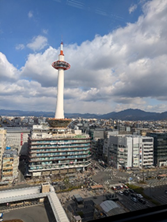Is a 10,000 yen tourist tax high or low? ≪3≫ ~How to use the tourist tax, the creation of the Okoshiyasu Program, and new tourism proposals Creation of the Heian Sky Corridor (Welcome Program) ~
Yoshie Doi

Photo taken on January 29, 2025 Kyoto Tower
Since the topic is accommodation tax, I would like to talk about the “Heian Sky Corridor” proposed by Kyosuzume. This idea was proposed by Kyo-Suzume’s Secretary General, Masami Otani. It is based on the desire to have people who visit Kyoto see the same scenery that the Heian people looked at every day 1200 years ago. It seems that many of the people who come to Kyoto in search of healing have submitted works to Kyosuzume’s “Love Letter to Kyoto” public contest.
Kyoto people have lived looking at the mountains of Higashiyama, Kitayama, and Nishiyama 365 days a year. This scenery heals the soul. Kyoto citizens are lucky to live looking at the mountains every day. I always feel relieved when I see the mountains of Kyoto through the tunnel from the Shinkansen.
We think it might be possible to raise funds for the construction of the corridor through crowdfunding. Below is our proposal.
Did you know that Yasunari Kawabata once lamented, “A town where you can’t see the mountains is not Kyoto to me?” If you could travel back in time 1,200 years before the founding of Heian-kyo, you might be able to see the scenery that the people of the capital looked out upon. Today, the Shijo area of Kyoto has become a business district lined with buildings, and all you can see from your office window is the buildings. You can no longer see the mountains from within Kyoto.
Kyo-Suzume believes that if there were a promenade on the ground, it might become a town where people can return to peace of mind. If you go up to the 60m high Top of Kyoto on the 14th floor of Kyoto Station Building or the RIHGA Royal Hotel, where you can see the mountains on three sides of Kyoto from the Shijo area, you might be able to slip back in time to the scenery of the Heian period. The phrase “Sanshisuimei” (mountain purple and clear blue) was created by Rai Sanyo at the end of the Edo period to describe the time of day, and is now used to describe Kyoto. When the sun sets, the surface of the water changes, the mountains turn purple, the sunlight reflecting on the river surface is truly beautiful, and the subtle changes in the colors of the mountains and water create a Kyoto-like landscape, which is part of the wabi-sabi culture. Around 4pm, you can enjoy this time.
One of the winning entries in the first “Love Letter to Kyoto” contest was “A Trip to Kyoto to See the Sunset over the Kamo River” (by Maria Noda). It’s a very memorable piece.
(Continued in the next issue)
The end of document
Translated by Masami Otani
